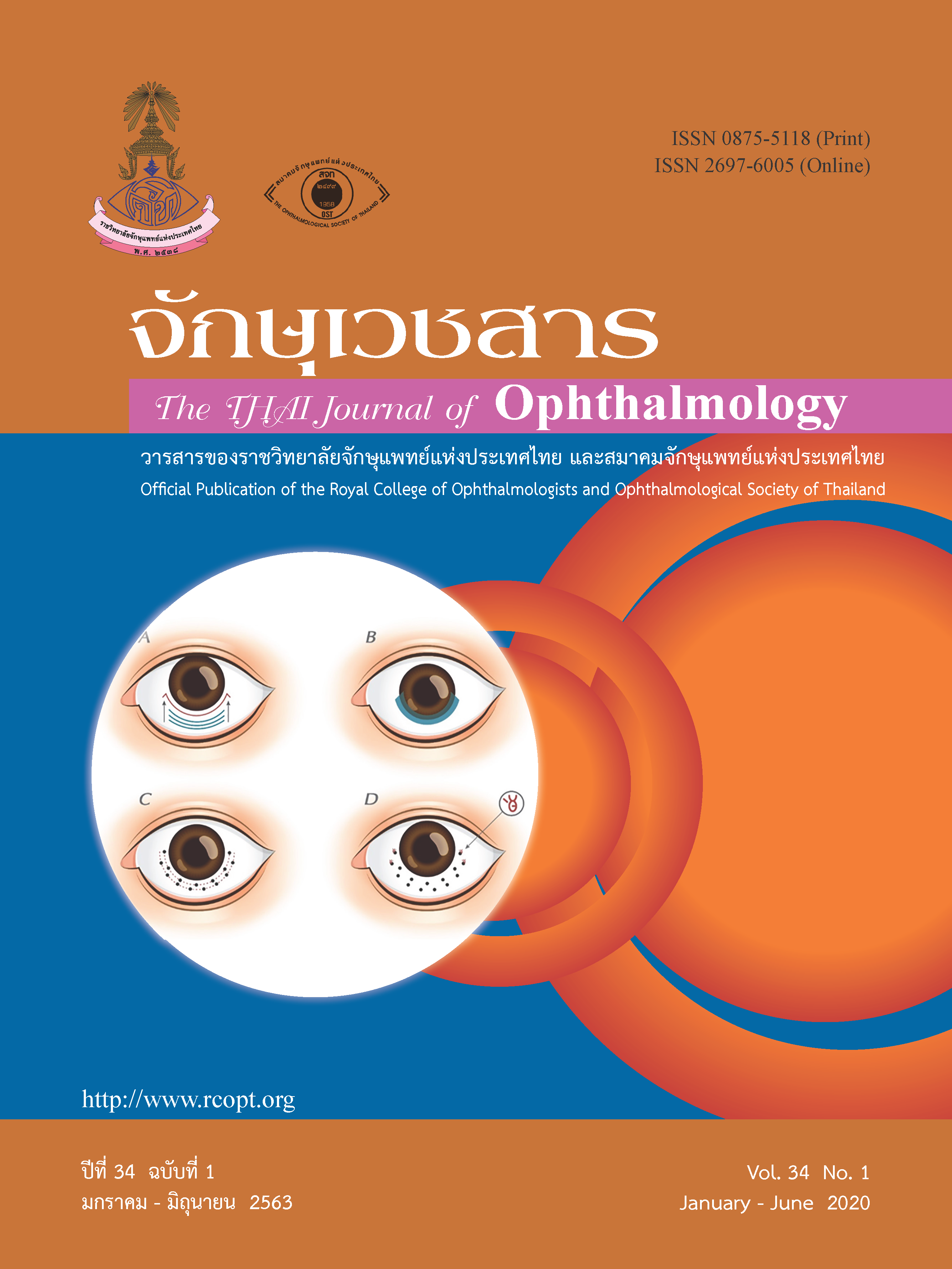Visual Prognostic Factors in Patients with Diabetic Macular Edema Treated with Intravitreal Bevacizumab at Samutprakarn Hospital
Keywords:
OCT characteristics, OCT predictors, Diabetic macular edema, Intravitreal BevacizumabAbstract
Abstract
Purpose: To analyze the factors from baseline characteristics of optical coherence tomography (OCT) for predicting the visual acuity after receiving the intravitreal Bevacizumab injection for treatment of
diabetic macular edema.
Methods: Retrospective study of 54 patients with diabetic macular edema at Samutprakarn Hospital from August 2018 to January 2020 was analyzed. Patients who met the criteria received monthly intravitreal
Bevacizumab injection at least 3 injections within 6 months. The visual acuity measurement and OCT were performed in each visit. Patients who improved VA ≥ 10 letter scores were considered in a good response group.
Results: After receiving treatment, patients had a significant improvement in VA. The mean VA at baseline, at 6 months and at last follow-up were 49.2, 58.5 and 56.5 letter scores (20/100, 20/70 and 20/80 Snellen Equivalent). After 3 months of treatment, there were 27 patients in good response group (50%). The analysis found that there was no OCT characteristic which had a significant relationship with the good response group. The OCT characteristic that tended to be significant for good VA response was the presence of subretinal fluid (SRF) in the baseline OCT (p-value 0.051).
Conclusion: There was no characteristic of any baseline OCT which can predict VA response after the injection. However, the presence of subretinal fluid in the baseline OCT may tend to correlate with the good VA response after receiving treatment.
good VA response after receiving treatment.
References
International Council of Ophthalmology (ICO) Updated 2017 ICO Guidelines for Diabetic Eye Care. http://www.icoph.org/downloads/ICOGuidelinesforDiabeticEyeCare.pdf. Assessed January, 2017.
Varma R, Bressler NM, Doan QV. Prevalence of and Risk Factors for Diabetic Macular Edema in the United States. JAMA Ophthalmol. 2014;132(11):1334-40.
Antonetti DA, Klein R, Gardner TW. Diabetic retinopathy. N Engl J Med. 2012;366(13):1227-39.
สำนักงานหลักประกันสุขภาพแห่งชาติ. คู่มือบริหารกองทุนหลักประกันสุขภาพแห่งชาติ ปีงบประมาณ 2561. https://www.nhso.go.th/files/userfiles/file/2017/005/N007. pdf. 2017. Accessed October, 2017.
Schmidt-Erfurth U, Garcia-Arumi J, Bandello F, et al. Guidelines for the Management of Diabetic Macular Edema by the European Society of Retina Specialists (EURETINA). Ophthalmologica. 2017;237(4):185-222.
Diabetes Control and Complications Trial Research Group. The effect of intensive treatment of diabetes on the development and progression of longterm complications in insulin-dependent diabetes mellitus. N Engl J Med. 1993;329:977-86.
Ohkubo Y, Kishikawa H, Araki E, et al. Intensive insulin therapy prevents the progression of diabetic microvascular complications in Japanese patients with non-insulin-dependent diabetes mellitus: a randomized prospective 6-year study. Diabetes Res Clin Pract. 1995;28:103-17.
UK Prospective Diabetes Study (UKPDS) Group. Effect of intensive blood-glucose control with metformin on complications in overweight patients with type 2 diabetes (UKPDS 34). Lancet. 1998;352:854-65.
American Diabetes Association Standards of Medical Care in Diabetes-2020. Diabetes Cares. 2020;43(Suppl 1):S66-76.
The Diabetic Retinopathy Clinical Research Network. Aflibercept, Bevacizumab, or Ranibizumab for Diabetic Macular Edema. N Engl J Med. 2015; 372(13): 1193-203.
Gerendas BS, Prager SG, Deak GG, et al. Morphological parameters relevant for long-term outcomes during therapy of diabetic macular edema in the RESTORE Extension trial. Invest Ophthalmol Vis Sci. 2015;56(7):4686.
Vujosevic S, Torresin T, Berton M, et al. Diabetic Macular Edema With and Without Subfoveal Neuroretinal Detachment: Two Different Morphologic and Functional Entities. Am J Ophthalmol. 2017;181:149-55.
Sun JK, Lin MM, Lammer J, et al. Disorganization of the retinal inner layers as a predictor of visual acuity in eyes with center-involved diabetic macular edema. JAMA Ophthalmol. 2014;132(11):1309-16.
Santos AR, Costa MA, Schwartz C, et al. Optical coherence tomography baseline predictors for initial best-corrected visual acuity response to intravitreal anti-vascular endothelial growth factor treatment in eyes with diabetic macular edema: The CHARTRES Study. Retina. 2018;38(6):1110-9.
Downloads
Published
Issue
Section
License
The Thai Journal of Ophthalmology (TJO) is a peer-reviewed, scientific journal published biannually for the Royal College of Ophthalmologists of Thailand. The objectives of the journal is to provide up to date scientific knowledge in the field of ophthalmology, provide ophthalmologists with continuing education, promote cooperation, and sharing of opinion among readers.
The copyright of the published article belongs to the Thai Journal of Ophthalmology. However the content, ideas and the opinions in the article are from the author(s). The editorial board does not have to agree with the authors’ ideas and opinions.
The authors or readers may contact the editorial board via email at admin@rcopt.org.


